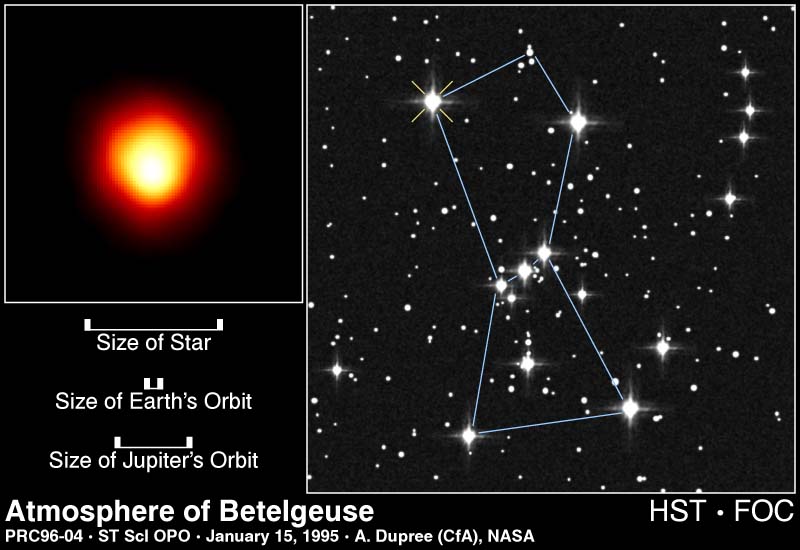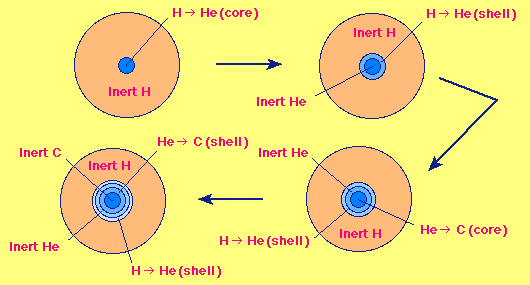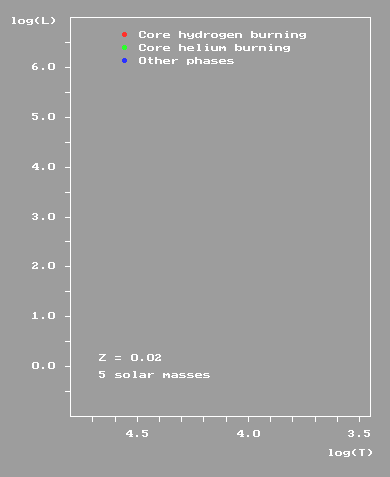3. STELLAR EVOLUTION
|

|
|
Left: Image of the red giant star Betelgeuse. This is one of the few stars near enough and big enough to resolve with the Hubble Space Telescope. Right: picture of the constellation Orion. Betelgeuse is the star in the cross-hairs in the upper left. For details, see Hubble Space Telescope Captures First Direct Image of a Star. |
When all the hydrogen is gone from the core of the Sun, the heat that leaks out as radiation cannot be replenished by hydrogen fusion reactions. Then, the core must shrink as it loses energy, and it will do so in about 20 million years, just as Kelvin and Helmholtz had predicted.
When the core shrinks, the compression due to gravity will actually
cause the gas to become hotter, not cooler. Moreover, the
shrinking core is surrounded by hydrogen gas that was too cool to burn when
the star was a main-sequence star. But now, as the core shrinks and becomes
hotter, the temperature of the hydrogen surrounding this core will rise
above the kindling temperature for hydrogen fusion reactions, and the
hydrogen will begin to burn in a thin shell surrounding the helium core,
which is not burning, as illustrated in the plot below. This shell burns fiercely, producing more luminosity than the core of the star did while it still had hydrogen to burn. In fact, the luminosity produced by the shell is so great that it cannot leak out of the envelope as fast as it is produced. Instead, it causes the outer envelope of the star to expand.
We call the resulting star a
red giant. The radius of its photosphere swells up by a factor of 100 or more compared to the radius it had as a main sequence star, and its luminosity increases by a factor of a few hundred. Its interior structure is totally different from that of a main-sequence star. The distended outer part of the star has very low density. But the inner core of the star, which contains about half the mass, is very small (about the size of Jupiter) and very dense.
When the Sun becomes a red giant, it will envelop the Earth, vaporizing the oceans and melting the rock into ceramic. People, if they exist then, should be prepared to colonize the Moons of Jupiter, or maybe Neptune or Uranus. Don't worry: we have plenty of time to get our rockets ready. But what will happen after that?
Helium burning:
the Sun will be a red giant for about 100 million years or so, as its helium core slowly continues to contract and get hotter. But then something remarkable happens. At temperatures above about 108 K (100 million), helium can fuse into carbon in a process called the triple-alpha reaction. It is described in this diagram and this movie. Since one carbon nucleus has less mass than the sum of three helium nuclei, this reaction releases energy (in the form of gamma ray photons). At sufficiently high temperatures some of the carbon will also fuse with another helium nucleus to form oxygen. But the energy yield per unit mass in these reactions is less (by a factor of about 1/7) than that from the fusion of hydrogen into helium.
When the temperature of the helium in the core of the red giant star rises above 108 K, the triple-alpha reaction turns on suddenly, in a phenomenon called the
helium flash. The core suddenly expands due to the increased energy production. This expansion causes the hydrogen burning shell to diminish in luminosity, and this causes the outer envelope of the star to shrink back again, from a few hundred solar radii to about 10 solar radii. The resulting star is called a horizontal branch star, and its interior structure is illustrated in your text, Fig. 16.10 and below.
|

|
|
Evolution of the interior structure of a star somewhat (2 - 5 x) more massive than the Sun. The first stage (upper left) illustrates the main sequence phase. The upper right illustrates the first red giant stage. The lower right illustrates the horizontal branch stage, and the lower left illustrates the asymptotic giant stage. The diagrams are not to scale. For example, the diameter of the star in the upper right is roughly 100 times that of the star in the upper left. From Astronomy 162, by the University of Tennessee. |
Horizontal branch stars are called so because of their locations on the Hertzsprung-Russell diagram (stages 9 - 10 in the diagram below). In Lesson 4, we showed a
color-magnitude diagram of the globular cluster M3. Note that M3 has no luminous blue main sequence stars. In fact, the only main sequence stars (labeled MS) are solar type or redder. M3 has many red giant stars, labeled RGB, and horizontal branch stars, labeled HB, that lie on a horizontal strip. The HB stars have roughly the same temperature as the Sun and so have spectral types in the range A - G, but they are almost 100 times as luminous as the Sun. They are all burning helium in their cores.
To review how the external appearances of stars evolve through the red giant and AGB stages, you should play with this
stellar evolution simulator, by Terry Herter of Cornell University.
But, after about another 50 million years or so, the helium in the core of the HB star all turns to carbon and oxygen, and these elements can't burn at the temperatures (100 - 200 million degrees) in the core of the HB star. Therefore, the carbon-oxygen core begins to shrink again. As it becomes hotter and denser, the surrounding helium begins to burn furiously in a shell. Once again, the shell burning produces more luminosity than can escape through the envelope of the star, so the star swells up again to a red giant star. But this star has a different internal structure than it did the last time it was a red giant (before it became a horizontal branch star). It contains a very dense carbon/oxygen core that is not burning, surrounded by a burning shell of helium, surrounded by a burning shell of hydrogen, surrounded by a hydrogen envelope. The internal structure is illustrated above.
These kinds of red giant stars, called Asymptotic Giant Branch stars, or
AGB stars, are the last stage shown on the animation below. From the outside, AGB stars are hard to distinguish from red giant stars, except that they tend to be more luminous. So we can't be sure, for example, whether Betelgeuse has a core composed of helium or of carbon/oxygen.
|

|
|
Evolution of a 5 solar mass star. From Star Clock. Press reload to restart. For more details, see evolution. |
(Return to course home page)
Last modified September 23, 2000
Copyright by Richard McCray


